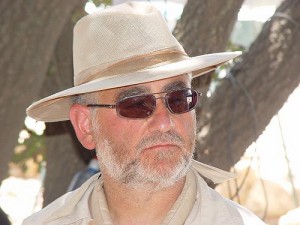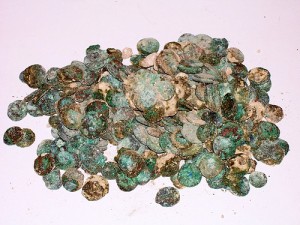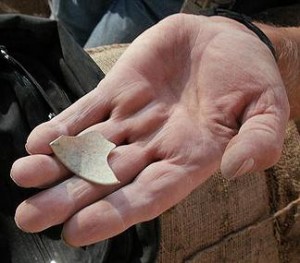Wednesday, September 3: Tune It Or Die!
A THOUSAND STORIES DEEP
by Rob Lopresti
 This continues last week’s tale of how I spent my summer vacation: volunteering at an archaeological dig in Israel. By the way, this photo by my fellow digger John Vanee shows me meditating on one of the major decisions of the volunteer’s day: grape or cherry popsicle at break?
This continues last week’s tale of how I spent my summer vacation: volunteering at an archaeological dig in Israel. By the way, this photo by my fellow digger John Vanee shows me meditating on one of the major decisions of the volunteer’s day: grape or cherry popsicle at break?
John also taught me someone’s definition of an archaeologist: “A person who can can dig a square hole and tell an interesting story about it.”
There’s some truth in that, because the hole and its contents don’t actually tell you anything. You have to interpret the results, which are always partial. As I said last week, experts will disagree with each other as to what a given find or site means.
But if you are a writer—or even a big reader—of fiction, you can’t help but tell your own stories.
For the birds
For example, there was one discovery that got us a story in Ha’aretz, a major Israeli newspaper. The diggers were exploring a columbarium—a cave containing triangular wall niches where pigeons lived. The dig director, Oded Lipshits, said pigeons were the chickens of the iron age, used for food, providers of useful guano, and as sacrifices at the temple. In one of the bottom niches the researchers found a small pot and in the pot they found fifteen silver shekel coins. (The article says they were gold. They weren’t.)
 This photo, by another digger named Carnadine, is NOT of those coins. It is a much bigger hoard (called a “Byzantine bank” by one of the bosses) that was found a few days earlier. I can’t find a picture of the silver pile.
This photo, by another digger named Carnadine, is NOT of those coins. It is a much bigger hoard (called a “Byzantine bank” by one of the bosses) that was found a few days earlier. I can’t find a picture of the silver pile.
But whichever pile of coins you consider, the question that comes to mind is: who hid them there? Why didn’t he come back for them? Did he die of natural causes, or was he killed? Did his family know there was treasure hidden somewhere, but were unable to find it? What was the story?
Lost and found
I thought the coolest discovery we made was a red ball the size of a grape. It was made of what Lipshits called “half-expensive stone” (Okay, he meant “semi-precious,” but don’t you like his version better?). A hole had been drilled through it so you could wear it on a string around your neck, and a picture had been carved into one side. The carving was, in fact, a seal, used to prove that documents were official, and to keep them confidential. An impression in clay was quickly made and photographs of the seal and impression were sent to two experts. They tentatively agreed that this was an official seal from the Second Persian Empire who ruled Jerusalem for about one decade 1400 years ago.
Which official lost that seal? Did the string simply break one day or did someone steal it from him? Was it used to forge documents? Did this somehow hasten the fall of the empire? What was the story?
Open ended
We won’t ever know, but the human mind can’t help but ask the question. And that’s what keep the storytellers in business.
 Here’s one of my personal finds on the dig. Nowhere near as exciting – just a bit of broken glass a thousand years old. But someone drank from that glass, or perhaps stored perfume in it …
Here’s one of my personal finds on the dig. Nowhere near as exciting – just a bit of broken glass a thousand years old. But someone drank from that glass, or perhaps stored perfume in it …
Bicycling home today I saw the following objects lying on or near the street:
- a McDonald’s bag, miles from the closest McDonalds.
- a large canvas drawstring bag
- a child’s doll, wearing an orange dress
Each of those objects has a story, too, but no archaeologist is going to tell it.
Are you?
Another thread from the web
If you want to read more about my adventures at the dig (stomach viruses! mysterious toothbrushes in my bathroom! non-dairy cheesecake!) you can find my whole travel diary at my other blog, Fifteen Iguana.




















No comments on this yet?!?! Not even from pesky me??!! Thanks for the glimpse of the dig, I don’t have the patience to garden, let alone unearth the aincient world!